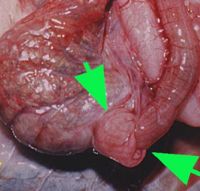Difference between revisions of "Lizard Enteritis"
Jump to navigation
Jump to search
| Line 1: | Line 1: | ||
{{review}} | {{review}} | ||
| − | [[Image:Lizard_enteritis.jpg|200px|thumb|right|'''Intussusception may occur as | + | [[Image:Lizard_enteritis.jpg|200px|thumb|right|'''Intussusception may occur as secondary to enteritis''' (Copyright © RVC)]] |
Enteric infections that result in clinical problems are, in general, uncommon. They are usually related to poor husbandry. | Enteric infections that result in clinical problems are, in general, uncommon. They are usually related to poor husbandry. | ||
Revision as of 14:58, 18 May 2010
| This article has been peer reviewed but is awaiting expert review. If you would like to help with this, please see more information about expert reviewing. |
Enteric infections that result in clinical problems are, in general, uncommon. They are usually related to poor husbandry.
Clinical signs include vomiting (grave prognosis) and diarrhoea.
Diagnosis - history, physical examination, faecal cultures, radiology, haematology and biochemistry.
Treatment:
- Symptomatic therapy (e.g. kaolin)
- Increased dietary fibre (bran, hay, alfalfa pellets)
- Oral inoculation of parasite-free faeces from a healthy iguana
- Antibiotics
- Supportive care
